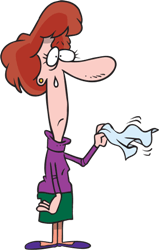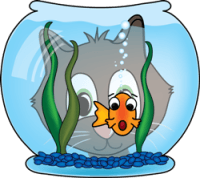Understanding the
Parts of a Sentence
Subject | Predicate | Direct Object | Indirect Object
Object of the Preposition | Transitive Verbs and Intransitive Verbs
Linking Verbs | Complements | Exercises
Understanding the parts of a sentence in English is crucial to your success in learning English.

Click Here for Step-by-Step Rules, Stories and Exercises to Practice All English Tenses
In this section we will learn:
- What is
a sentence?
- What are
the
different parts of a sentence?
- And how do you construct proper sentences in English?
Read also:
Independent and Dependent Clauses
How to Use Relative Clauses (Who, Which, That, Whose, Where, When)
What is a Sentence?
A sentence is a group of words that expresses a complete idea."She feels sad." <-- A complete idea

These are sentences (they express a complete idea):
- I like to swim.
- Jane bakes tasty cookies.
- Mark will quit his job.
These are not complete sentences (they don't express a complete idea):
- She gave me the.
(What did she give me?)
- Will build the house.
(Who will build the house?)
- Tony
watching a movie.
(Is Tony watching the movie now? Was he watching the movie in the past? Or will he be watching the movie in the future?)
A sentence can express:
- A statement.
Example: You are tall.
- A question.
Example: Are you tall?
- An order.
Example: Be tall!
- A wish.
Example: I wish I were taller.
Writing tips
1) In written English sentences begin with a capital letter.Correct: You are tall.
Incorrect: you are tall.
2) Sentences can end with a period (.), a question mark (?), an exclamation point (!) or an ellipsis (. . .).
Correct: You are tall.
Incorrect: You are tall,
Incorrect: You are tall . . . . . . .
Incorrect: You are tall
Why Should You
Know
the Parts of a Sentence?
Once
you know the parts of a sentence, and how to combine them, you can
form logical sentences that will be well understood by others.People usually prefer working with other people they can easily understand, so this is a very important quality to have for the workplace. Not to mention any other situations that involve other people!
Moreover, once you master the parts of a sentence, you can easily understand other people's sentences. That can make you really smart!
So go ahead and learn the English parts of a sentence.
Understand them, and practice using them in properly constructed sentences.
This can serve you tremendously!

What Are the Parts of a Sentence?
A sentence must minimally have a subject and a verb. Sometimes the subject can be omitted if it is understood.In the following examples the subject is green and the verb is brown:
Tom walks.We met Susan.
They are washing the dishes.
Lisa will arrive soon.
She is nice.
There is food on the table.
Leave!
(The subject in this sentence was omitted, since it is understood to be "you": You leave!)
There are other parts of a sentence you can use, in addition to a subject and a verb.
Here is a list of the parts of a sentence (and other relevant subjects):
- Subject
- Predicate
- Direct
object
- Indirect
object
- Object
of the preposition
- Transitive
verbs and intransitive verbs
- Linking
verbs
- Complements
Subject | Predicate | Direct Object | Indirect Object
Object of the Preposition | Transitive Verbs and Intransitive Verbs
Linking Verbs | Complements | Exercises | Top
Subject
The subject is the person or thing about which something is being stated.
Who is a good boy?
Joe is.
So "Joe" is the subject.
Click here for the full article on the English subject.
Object of the Preposition | Transitive Verbs and Intransitive Verbs
Linking Verbs | Complements | Exercises | Top
Predicate
The predicate is the part of a sentence that tells something about the subject.The predicate always includes a verb.
("Predicate" is also a verb that means, "to state something.")

The subject is Joe.
Now, what about Joe?
He is a good boy.
So "is a good boy" is a predicate.
Click here for the full article on the English predicate.
Object of the Preposition | Transitive Verbs and Intransitive Verbs
Linking Verbs | Complements | Exercises | Top
Direct Object
A direct object is a person or thing that is affected by the action of the verb. You could say that the direct object "receives the action of the verb."
What was affected by the action? The window was.
So "the window" is the direct object.
Click here for the full article on the English direct object, indirect object and object of the preposition.
Object of the Preposition | Transitive Verbs and Intransitive Verbs
Linking Verbs | Complements | Exercises | Top
Indirect Object
An indirect object is a person or thing that the action is done to or for.The indirect object usually comes just before the direct object.
You could also say that the indirect object is the receiver of the direct object.

To whom did he give the flowers? To his mother.
So "his mother" is the indirect object.
Click here for the full article on the English direct object, indirect object and object of the preposition.
Is it a direct object or an indirect object?
How can you tell a direct object from an indirect object?Here are some tips to help you:
1) A direct object receives the action of the verb. In other words, it is directly affected by it.
2) An indirect object is the receiver of the direct object, and it usually comes just before it.
Let's have another look at some of the previous examples (the direct object is green, the indirect object is brown):

The verb is "gave."
Who is directly affected by this action?
The flowers. They are given!
So "flowers" is the direct object.
Who receives the flowers? His mother.
So "his mother" is the indirect object.
You can see that the indirect object ("his mother")
is located just before the direct object ("flowers").
Click here for the full article on the English direct object, indirect object and object of the preposition.
Object of the Preposition | Transitive Verbs and Intransitive Verbs
Linking Verbs | Complements | Exercises | Top
The Object of the Preposition
Click here if you want a review on what is a preposition.The object of the preposition is a noun or a pronoun that completes its meaning.

Example 1:
- She is thinking about.
Here is the complete version:
- She is thinking about your idea.
Click here for the full article on the English direct object, indirect object and object of the preposition.
Object of the Preposition | Transitive Verbs and Intransitive Verbs
Linking Verbs | Complements | Exercises | Top
Transitive
Verbs
and Intransitive Verbs
Not every verb
takes a direct
object.The direct object completes the meaning of the verb, but not every verb needs completion.
For example:
- I built last year.
To complete the idea I should add a direct object: "I built a house last year."
Now the idea is complete.
An opposite example:
- I ran yesterday.
Definitions
Verbs that take
direct objects are called transitive verbs.The meaning of a transitive verb is incomplete without a direct object.

Verbs that don't take direct objects are called intransitive verbs.
The meaning of an intransitive verb is complete on its own.

Click here for the full article on English transitive verbs and intransitive verbs.
Object of the Preposition | Transitive Verbs and Intransitive Verbs
Linking Verbs | Complements | Exercises | Top
Linking Verbs
A linking verb is a verb that connects the subject with an adjective or a noun that identifies or describes it.
Click here for the full article on English linking verbs.
Object of the Preposition | Transitive Verbs and Intransitive Verbs
Linking Verbs | Complements | Exercises | Top
Complements
A complement is a word or a group of words (usually an adjective or a noun), that is used after linking verbs (such as be and become). The complement identifies or describes the subject of the verb.
Click here for the full article on English complements.
Object of the Preposition | Transitive Verbs and Intransitive Verbs
Linking Verbs | Complements | Exercises | Top
English
Parts of a Sentence Exercises,
Identify the Part of a Sentence
Understanding English parts of a senence is an important part of truly
mastering English, so make sure you know what they are and can use them
without hesitations.
Now let's practice!
English
Parts of a Sentence Exercises 1
English
Parts of a Sentence Exercises 2
English
Parts of a Sentence Exercises 3
English
Parts of a Sentence Exercises 4
Parts of a Sentence Review and Worksheet
Illustrated Worksheet on Parts of a Sentence
See also: How to Keep Your Sentences Balanced and Consistent Using Parallel Structure
Get Updates, Special Offers, and English Resources
Download your FREE GIFT (the first two chapters of
English Short Stories Book and Workbook)
as soon as you join!

By submitting your email, you consent to receiving updates and newsletters from us and to the sharing of your personal data with third parties for the purposes of sending you communications. We will not spam you. You can unsubscribe at any time. For more information, please see our privacy policy.
Return from Understanding
the Parts of a Sentence
to Easy English Grammar
Return from
Understanding the Parts of a Sentence to
Learn to Write in English





